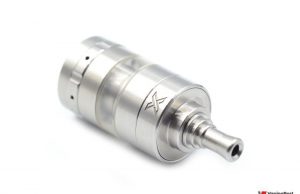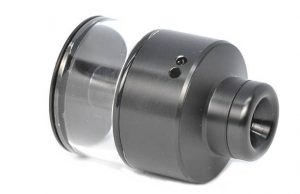That’s probably the most tightly-guarded secret when you start getting into rebuildables. Which wire, how many turns, on what size of pin, are the turns close together or spaced out?
The easiest way is to get started in two steps. First make coils that will give you the vaping style you want, and secondly optimize your assemblies. To start with, you’d be better to use single coils instead of claptons or other complex coil designs. They’re easier to work with, and you can use any on-line calculator to find out how many turns you need for the wire you’re using and the power you want.
Start with simple assemblies, usually 5 or 6 turns on a 2.5 or 3 mm pin to get your hand in. Once you’ve managed assemblies like these, the principles are much easier to grasp and the differences become more obvious too. You can then try out more complex assemblies as you’ll have got the hang of it, and discovered what works and what doesn’t.
Sometimes you need a few tries before you find the best assembly, the one that gives the best results with an atomizer, refining as you go.
While most atomizers on the market cost from 30 to 60 Euro, for some models makers will happily charge you over 100 Euro. The question, then, is whether they’re worth the difference in price. The answer is not as straightforward as you might think.
Large-scale production models have made huge progress in recent years, and being able to compare their build quality with high-end models is no longer that unusual. And anyway, any differences between them are now pretty minimal. Gone are the days of having to break the bank to get a good quality atomizer, which is great news. At least it is for users. It’s not so good for manufacturers of high-end kit, who have to justify their prices through truly exceptional performance or with truly original design.
Nor can we ignore our own subjectivity when it comes to choosing an atomizer. Every decision is irrational to some extent: we might like an atomizer just because of the way it looks, or feel an emotional draw to a specific maker. Which is still an excellent reason to get a top-of-the-range model!
One potential advantage of rebuildables is that you can clean the coils instead of replacing them each time. This avoids having to make them again, which saves you a little time and energy, and a small amount of money.
The most effective method is to dry burn the coil. Take out the wick and just heat the coil until it glows. Repeat this several times, and rinse the coil under cold running water once it’s glowed for a few seconds. Then brush it with a suitable tool (like an old toothbrush), and finally dry it with a dry cloth or leave it to air dry. The result is pretty impressive: all the residue goes, leaving the metal looking like new and ready to use.
But be careful. You might notice that the colour of the coil has changed, and in fact its surface changes chemically at very high temperatures. This has led some scientists to say we shouldn’t use the dry burn method, and should replace clogged coils with new ones.





 With a clearomizer, you change the coil when it wears out. With an atomizer, you make your own coil, giving rise to the name “rebuildable”. These atomizers feature a mounting plate with two posts, one that’s connected to the positive pole of the battery, the other to the negative pole, so you can mount the coil. To do that, you wind round a suitable wire. You also insert the cotton wick by hand. Compared to ready-made clearomizer coils, rebuildables are less practical and it certainly takes time to learn how to use them. Making your own assembly isn’t rocket science, but you need to understand some basic concepts and practise a bit before you can do it properly. Fortunately, doing it yourself has its advantages.
With a clearomizer, you change the coil when it wears out. With an atomizer, you make your own coil, giving rise to the name “rebuildable”. These atomizers feature a mounting plate with two posts, one that’s connected to the positive pole of the battery, the other to the negative pole, so you can mount the coil. To do that, you wind round a suitable wire. You also insert the cotton wick by hand. Compared to ready-made clearomizer coils, rebuildables are less practical and it certainly takes time to learn how to use them. Making your own assembly isn’t rocket science, but you need to understand some basic concepts and practise a bit before you can do it properly. Fortunately, doing it yourself has its advantages. The first benefit is financial. Making your own coils only needs very basic equipment and you’ll quickly recoup the small initial outlay. Whereas a clearomizer coil costs 2 to 4 Euro on average, an assembly costs only a few cents. But the main advantage of rebuildables is the total freedom they give you to make your own coils. You choose the type of wire, the diameter and the number of turns depending on the vaping experience you want. You can experiment and tweak your design until you find your perfect assembly. Until only recently, there was a major difference in vaping quality between rebuildables and clearomizers. In particular, flavour rendering was noticeably better with rebuildables. But manufacturers have made huge progress with coils and the difference is now much less obvious. In fact, some clearomizers render flavour incredibly well. But the best rebuildables are still better for flavour rendering, plus they give enthusiasts the chance to experience tailor-made vaping with their atomizer. Rebuildables aren’t the only way to experience high-quality vaping any more, but for enthusiasts they are still the best option.
The first benefit is financial. Making your own coils only needs very basic equipment and you’ll quickly recoup the small initial outlay. Whereas a clearomizer coil costs 2 to 4 Euro on average, an assembly costs only a few cents. But the main advantage of rebuildables is the total freedom they give you to make your own coils. You choose the type of wire, the diameter and the number of turns depending on the vaping experience you want. You can experiment and tweak your design until you find your perfect assembly. Until only recently, there was a major difference in vaping quality between rebuildables and clearomizers. In particular, flavour rendering was noticeably better with rebuildables. But manufacturers have made huge progress with coils and the difference is now much less obvious. In fact, some clearomizers render flavour incredibly well. But the best rebuildables are still better for flavour rendering, plus they give enthusiasts the chance to experience tailor-made vaping with their atomizer. Rebuildables aren’t the only way to experience high-quality vaping any more, but for enthusiasts they are still the best option. Like clearomizers, atomizers fall into two main categories: those designed for direct inhalation and those intended for MTL. Their air intakes are different. MTL devices have a much smaller intake to restrict air flow, and MTL mounting plates are also smaller. So the posts are also designed to work with the smaller sizing. On the other hand, atomizers designed for high-powered use have posts designed to accommodate bigger assemblies, often using wires like claptons and other unusual designs. Some atomizers are relatively versatile, but are fundamentally designed and optimized for one vaping style. Another difference is whether they use single or dual coils, depending on the number of coils they hold, how you fill them, whether the air flow is on the top or the bottom, and more. Being well aware that these appeal to discerning enthusiasts, manufacturers are keen to explore all the options and regularly bring out new ideas.
Like clearomizers, atomizers fall into two main categories: those designed for direct inhalation and those intended for MTL. Their air intakes are different. MTL devices have a much smaller intake to restrict air flow, and MTL mounting plates are also smaller. So the posts are also designed to work with the smaller sizing. On the other hand, atomizers designed for high-powered use have posts designed to accommodate bigger assemblies, often using wires like claptons and other unusual designs. Some atomizers are relatively versatile, but are fundamentally designed and optimized for one vaping style. Another difference is whether they use single or dual coils, depending on the number of coils they hold, how you fill them, whether the air flow is on the top or the bottom, and more. Being well aware that these appeal to discerning enthusiasts, manufacturers are keen to explore all the options and regularly bring out new ideas. We assess a lot of factors during our testing, but three stand out. Production quality, ease of assembly and flavour rendering. Certain criteria, such as excessive hissing from the air flow, can also bring down a model’s score. The best atomizers are the ones manufactured to have a long life and be totally reliable, designed to be easy to assemble and that produce wonderful tasting, dense vapour. Ultimately, our tests are simple but extremely demanding.
We assess a lot of factors during our testing, but three stand out. Production quality, ease of assembly and flavour rendering. Certain criteria, such as excessive hissing from the air flow, can also bring down a model’s score. The best atomizers are the ones manufactured to have a long life and be totally reliable, designed to be easy to assemble and that produce wonderful tasting, dense vapour. Ultimately, our tests are simple but extremely demanding.
